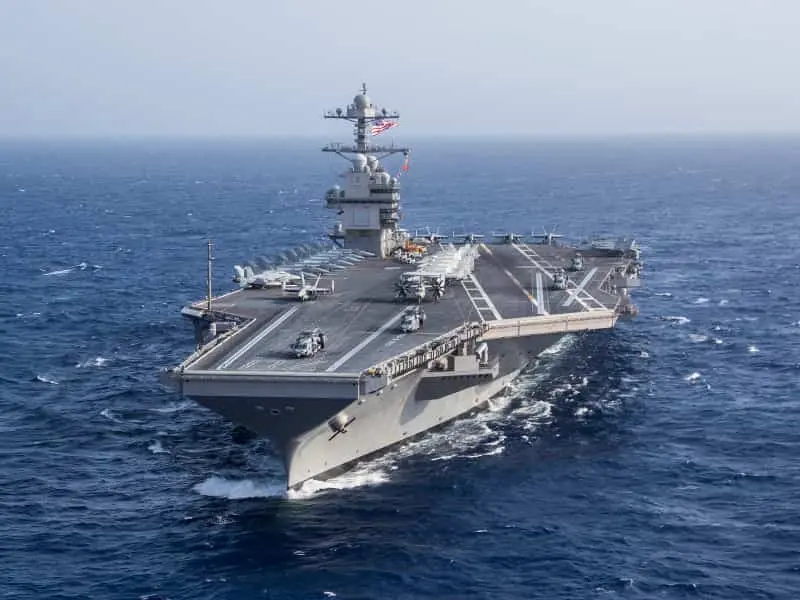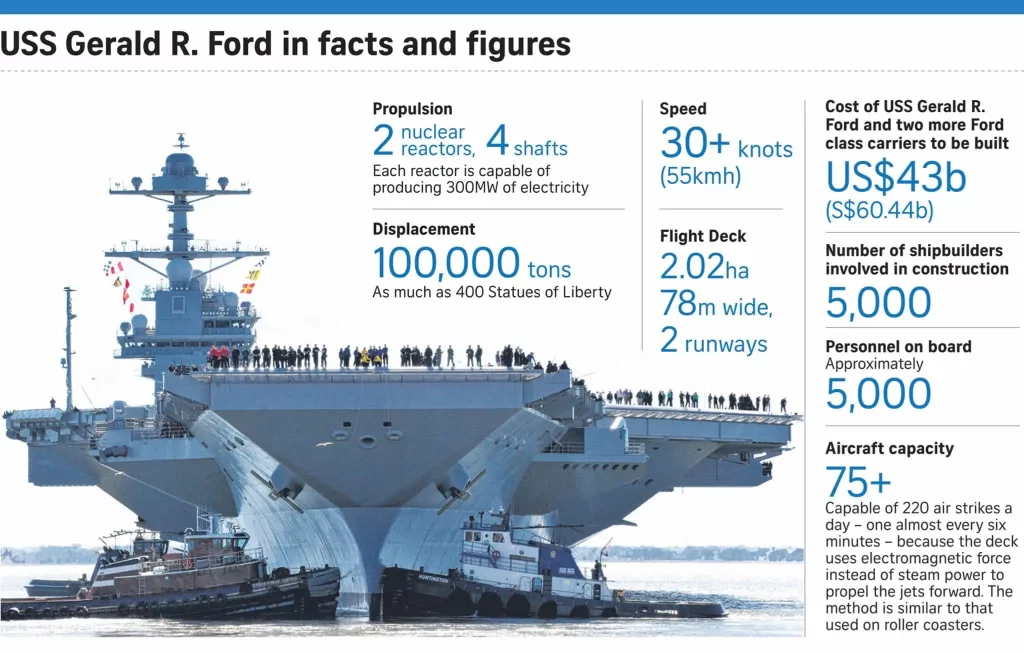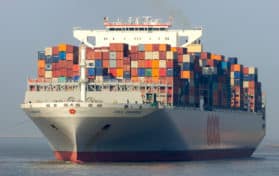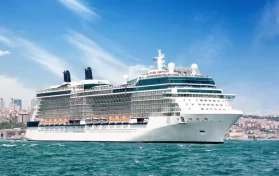
Although the Wright brothers flew their plane at Kitty Hawk, North Carolina in 1903, it wasn’t until after World War I that planes were commissioned for combat. In fact, during World War I, planes were used mainly for reconnaissance purposes. That war ended in 1918, and it was four years later when the first United States aircraft carrier, the USS Langley, was repurposed to become the first official ship of such distinction.
Air carriers served a highly important role in the Pacific theater of World War II, with the USS Enterprise garnering quite a reputation (the USS Enterprise was the most decorated warship of WWII). Shipbuilding has progressed rapidly since the Langley and the Enterprise served the United States Navy, and today, the USS Gerald R. Ford is the most advanced aircraft carrier in the world.
What is the history of the USS Gerald R. Ford aircraft carrier?
The construction of the USS Gerald R. Ford officially began when the Navy signed a contract with a shipyard in Newport News, Virginia, Northrop Grumman Shipbuilding. The company would not only build the carrier, but design it as well. However, three years prior in 2005, Northrop had agreed to begin “advance construction” of an aircraft carrier.
It was just over one year later (2009) when President Ford’s daughter, Susan, would take part in a ceremony during which the keel of the ship was laid. Mrs. Bales addressed those present at the ceremony, marking her father’s own service on an aircraft carrier (Ford served on the USS Monterey, where he was an assistant navigator, athletic officer, and anti-aircraft battery officer) and speaking of her father’s presidency.
However, the USS Gerald R. Ford met several delays in its own construction. Two years after the initial ceremony and laying of the ship’s keel, the carrier was said to be about fifty percent “structurally complete.” The lower bow was lifted into place by May 2012, and by December of that same year, Huntington Ingalls (by 2012, Northrop Grumman had acquired this subsidiary company and renamed its Newport News location as such) announced that the ship was ninety percent (structurally) complete.
Another ceremony for the USS Gerald R. Ford was held on January 26, 2013 when the island was landed. The ship was considered to be 100 percent complete by May of that year when all superlifts were put into place.
However, multiple production delays prevented the initial launch of the aircraft carrier. A naming ceremony for the carrier took place in 2013, but the ship was not delivered until February 2016. A great deal of testing took place between 2013 and its delivery. Budget issues also contributed to the delay in delivery of the USS Gerald R. Ford. By 2013, the cost to build the ship had exceeded its initial budget by over twenty percent.
Even so, President Ford’s daughter, Susan Ford Bales, took part in a christening ceremony in 2013. A time capsule had been installed on the ship; this capsule included some Navy coins as well as a sandstone from the White House and aviator wings belonging to the first commanding officer of the USS Gerald R. Ford.
By 2016, a memo obtained by the main stream media showed that the USS Gerald R. Ford was experiencing issues with some of its major flight systems, which would further delay the delivery of the aircraft carrier. These weren’t the only issues that would plague the carrier between 2016 and 2018; there were also issues with munitions elevators as well as the nuclear propulsion system of the ship. In addition, the cost of constructing the boat had risen to $13.027 billion (over the original $12.8 billion). At that point, the USS Gerald R. Ford was the most expensive warship to be built.
While the USS Gerald R. Ford was formally commissioned in 2017, the aircraft carrier has yet to be deployed. In December 2021, the Navy “quietly declared” that the carrier was now operational. The Navy plans to officially deploy the ship sometime in 2022. Sea trials are currently being held prior to this formal declaration.

What makes the USS Gerald R. Ford exceptional?
A former Chief of Naval Operations, Admiral Jonathan Greenert, has described the USS Gerald R. Ford as a “technological marvel.” The aircraft carrier is a part of a new series of warships aptly titled the “Ford class.” These carriers will offer the latest in technological upgrades, including a new method of launching aircraft.
The USS Gerald R. Ford will utilize EMALS, or Electromagnetic Aircraft Launch System, to propel aircraft from the ship. EMALS will replace the steam launching system that aircraft carriers have utilized since the 1950s. EMALS employs a linear induction motor (LIM), which uses electric currents to generate magnetic fields that propel a carriage along a track to launch the aircraft. Overall, designers believe that this change will improve the lifespan of aircraft.
While the USS Gerald R. Ford will utilize EMALS to launch its planes, the ship will also use a new landing procedure which is also believed to be not only safer for pilots, but also simpler than the previous method of getting plans back on board. No longer will pilots use the current system with tailhooks and hydraulic systems, but now an electromagnetic system will be employed. This means the USS Gerald R. Ford and other aircraft carriers in the Ford class (CVN 78) will be able to land both manned and unmanned aircraft.
One reason these advances are special is not only are they revolutionary, but they are also intended to help cut costs of operation over time. Because these systems employ a great deal of automation, designers predict that at least $4 billion can be saved over the ship’s lifetime due to the presence of a smaller crew. The arresting gear is self-maintaining at many levels, but, should the AAG need maintenance carried out by crew members, the system sends out an alert. Overall, this means both less time in carrying out maintenance and less people to perform work on this sector of the ship’s operation.
The USS Gerald R. Ford will also possess an improved radar system; this one is multifunctional and carries out volume search radar. Plus, the aircraft carrier has some stealth features that are meant to keep it undetectable or at least limit its detection when in use. The flight deck of the Ford is larger than previous aircraft carriers (the flight deck offers a width of 252 feet). The ship will be able to hold up to 90 aircraft at one time (previously, aircraft carriers typically carried 64 planes).
The Navy has said that the USS Gerald R. Ford will be able to carry “the most advanced (Naval) aircraft, including:
- the F-35C Lightning
- the Super Hornet (F/A-18E/F)
- the E-2D Advanced Hawkeye
- the EA-18G Growler
- unmanned aircraft
- helicopters (particularly the MH-60R/S)
What were some of the delays met when constructing the USS Gerald R. Ford? Why is it important that the engineers found solutions to these issues?
A Navy spokesperson related in early 2022 that there are a total of 23 new technologies incorporated in the design of the USS Gerald R. Ford. He also lamented that usually only up to three new technologies are introduced when designing a new ship, and that testing and making improvements to the new technologies on the Ford have contributed to the budget overruns and the longer testing times prior to the ship’s deployment.
One new technology that was found rather troubling had to do with the ship’s elevator systems. The system aboard the Ford is larger and possesses “more complex smart munitions in mind.” The elevators on board the USS Gerald R. Ford total eleven in number, and these elevators have been particularly designed so that moving weapons from place to place can take place more quickly.
The radar on board the USS Gerald R. Ford will no longer utilize the rotating antennas, but instead use Dual Band Radar or DBR. This radar is said to be able to operate across two frequency ranges. It is reputed to be not only reliable, but also require less maintenance than the current radar system on board Nimitz class carriers.
The USS Gerald R. Ford will utilize a newer type of nuclear reactor than previously designed aircraft carriers. The Ford will possess A1B nuclear reactors whereas the Nimitz carriers use A4W reactors. The A1B reactors are expected to offer triple the amount of power than A4W nuclear reactors.
The end goal of utilizing these new technologies will save money while also being more efficient and improve safety for sailors. However, so many new technologies at one time required more testing as well as the time needed to correct problems when detected.
Both EMALS and the AAG systems experienced breakdowns and failures during the testing process, which needed to be addressed and repaired. The Congressional Research Service revealed that one AAG system breakdown required a week to repair successfully; EMALS was once down for half that time after two separate failures caused the system to go offline.
By the end of 2021, however, even the elevators had been successfully tested and deemed operational. Shock trials were completed, and deployment is now expected sometime in 2022.
Although the EMALS and AAG systems seemed to be plagued with problems during testing, the systems are now greatly improved, according to Navy officials. Over 8,000 take-offs and landings have been conducted as a part of testing. The Ford has spent at least half of 2021 at sea, and it is expected to be a “capable carrier.”





